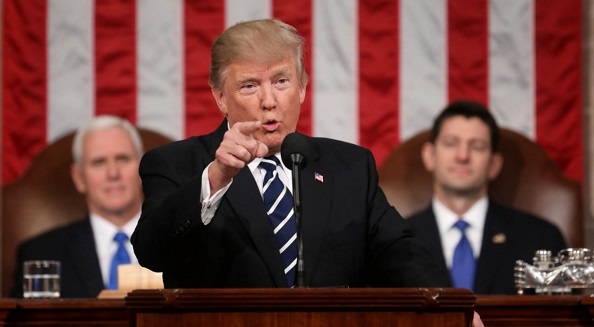
On Tuesday night, President Trump delivers his State of the Union address, as have scores of presidents before him. But the performance likely won’t do what it was originally designed for: framing a productive debate between two branches of government about the nation’s direction.
The State of the Union is in a state of decay, and has been since well before the age of Trump.
The Constitution states that the president “shall from time to time give to Congress Information on the State of the Union, and recommend to their Consideration such Measures as he shall judge necessary and expedient.” This directive is the ground from which our modern practice, bedecked with mass media pomp and circumstance, has grown. Televised viewership of the address has averaged around 40 million over the past decade. Theoretically, this gives the president a chance to lay out his vision for the country, to the country.
But is that what the address really does in practice?
Consider recent research by William Howell, Ethan Porter and Thomas Woods, which suggests that major presidential speeches such as the State of the Union can improve public perceptions of the president, especially among those who start with negative views of the speaker, without affecting viewers’ policy positions. The “power of public performance” has an effect independent of the message.
Further, while the president’s nominal audience is Congress, the real target is the American public beyond Congress, whom he can cajole while berating his partisan foes in the chamber before him.
As a result, the speech has become an unapologetically partisan performance, one part legislative manifesto, one part victory lap. Complete with its own hashtag, “SOTU” is a distillation of U.S. political culture, with the president’s expanded public role and the rise of “executive-centered partisanship” on full display.
It hasn’t always been this way.
Technology changed the State of the Union into a public performanceDeveloping technologies have changed the State of the Union, beginning with its broadcast on radio in 1923 and later on television in 1947. Today, as Trump frequently demonstrates, the president can promote his image and message more directly than ever through social media. These technologies shifted the president’s focus from the legislature in front of him to the voting public beyond them.
Heightened publicity stoked partisanship, a development emphasized in 1966 with the advent of the opposition “response.” Often delivered in the form of a rebuttal, the out-party’s response allows a partisan critique of the president’s assessment of what is “necessary and expedient” for the Union.
Although the response could foster productive argument, in practice neither speaker nor respondent actually engages the other. The opposition speaker writes the response before the president’s speech has been delivered. The opposition party does not so much respond to the president as imagine what rejoinder the waiting audience wants to hear. While the president’s address is directed to the public over Congress’ heads, the opposition response is directed to the public over the president’s head.
The State of the Union has a more deliberative historyEarly on, George Washington and John Adams both gave spoken addresses to Congress; response came from Congress as an institution. As Jeffrey Tulis documents in his recently reissued book “The Rhetorical Presidency,” this period saw the development of a robust deliberative tradition around the president’s “Annual Message,” as it was then styled.
After it was delivered, the president’s message prompted debate in the House and Senate. First the constituent chambers and then the Congress as a whole would develop a response to the presidential message. The response was then delivered to the president, who would offer a response of his own. Here were the quintessential features of legislative behavior: debate, deliberation and compromise, all directed toward refining the views of divergent electoral constituencies into a coherent will and plan of action. This process, in turn, shaped subsequent presidential behavior and discourse.
Beginning with Thomas Jefferson in 1801, presidents ceased to deliver the address in person, instead submitting a report to Congress in writing. And Congress ceased to respond, much to Daniel Webster’s chagrin. Woodrow Wilson revived the pre-Jeffersonian practice of in-person delivery in 1913, but the legislative response stayed dormant. When the response finally was resurrected during the Johnson administration, it was partisan rather than institutional.
In other words, the State of the Union originally helped the executive and legislative branches deliberate, promoting needful legislation and effective administration. And for a time, it worked.
No more. Today the State of the Union is little more than a “partisan echo chamber” in which politicians enact constitutional forms while abandoning those forms’ original purposes.
The Constitution was designed to have different interests in oppositionU.S. constitutional design is famously rooted in the idea of ambition counteracting ambition. Opposing interests are supposed to engage and offset each other, while protecting liberty and advancing the common good. But for this to work, these opposing interests must be embodied in and channeled through institutions that offer distinctive political resources. The ambition James Madison describes in the Federalist Papers requires that political actors exploit the “constitutional rights” of the institutions in which they are embedded.
To do that, politicians would have to treat their institutions not as stages for performance but as mediums for political discourse — something Congress has increasingly failed to do. The State of the Union’s development shows a shift that resulted less from executive overreach as from Congress’s abdication of its own constitutional rights.
In a high-profile speech on the Senate floor in 2015, one of Trump’s critics, Sen. Ben Sasse (R-Neb.), described this as “symbiotic legislative under-reach.” However unlikely it may seem today, Congress could insist on its prerogative to launch real debate in response to the president — and do its part to strengthen the state of our Union.
Connor M. Ewing (@ConnorMEwing) is a postdoctoral research associate and lecturer in the Program on Constitutionalism and Democracy at the University of Virginia.